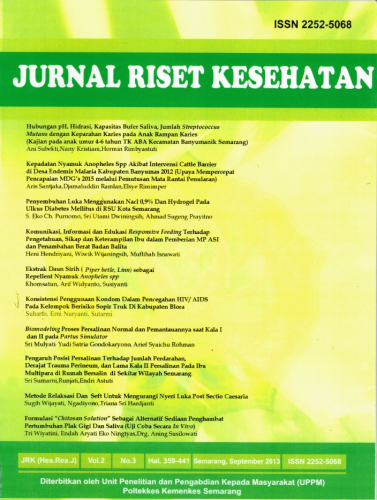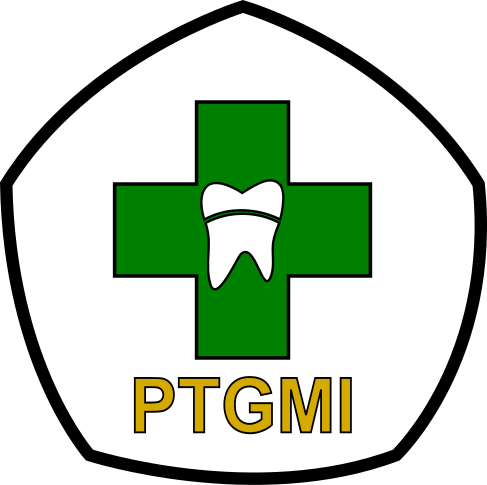EVALUATION OF PRECEPTORSHIP AND MENTORSHIP CLINICAL LEARNING METHOD ON NURSING STUDENTS' CRITICAL THINKING IN PROVIDING NURSING CARE IN A TEACHING HOSPITAL
Abstract
The demand for high-quality health services is increasing. It motivates nurses to utilize the best evidence in making decisions. Professional nurses were born from an excellent education. Preceptorship and mentorship clinical learning methods are expected to be able to answer these demands. This study aims to identify the effect of preceptorship and mentorship methods on students' critical thinking skills. The study design applies a quasi-experimental type pretest and post-test with a control group. Twenty-six students were examined as respondents for each intervention and control group, using a purposive sampling technique. The survey took place at a teaching hospital in Semarang, using a student-evidence-based practice questionnaire (validity 0.584-0.904; reliability 0.821) developed by Upton et al.in 2014. The intervention during three weeks with the training stages of clinical advisors, clinical guidance, internalization, and evaluation. Univariate data analysis is described by frequency and percentage (categorical) and mean and SD (numerical). Bivariate data analysis using a paired t-test and independent t-test. There was a significant effect of the preceptorship and mentorship methods on students' thinking abilities (p-value = 0.006). Integrated academic and clinical learning could form critical thinking skills among students. Educational institutions play a role in providing training for clinical instructors oriented to improving the ability of students to provide scientific evidence-based nursing care. The clinical instructors are responsible for improving students' critical thinking skills through preceptorship and mentorship learning methods.
Keywords
Full Text:
PDFReferences
Ashktorab, T., Pashaeypoor, S., Rassouli, M., & Alavi-Majd, H. (2015). Nursing Students' Competencies in Evidence-Based Practice and Its Related Factors. Nursing and Midwifery Studies, 4(4). https://doi.org/10.17795/nmsjournal23047
Benbassat, J. (2014). Role modeling in medical education: The importance of a reflective imitation. Academic Medicine, 89(4), 550–554. https://doi.org/10.1097/ACM.0000000000000189
Boström, A., Rudman, A., Ehrenberg, A., Gustavsson, J. P., & Wallin, L. (2013). Factors associated with evidence-based practice among registered nurses in Sweden: a national cross-sectional study Anne-Marie. BMC Health Services Research, 13(165), 1–12.
Budiman, A., & Septiawan, T. (2019). Pengaruh Penerapan Evidence Based Practice Terhadap Kemampuan Berpikir Kritis Mahasiswa S1 Keperawatan. PROFESI (Profesional Islam): Media Publikasi Penelitian, 17(1), 1–7. ejournal.stikespku.ac.id
Burgess, A., Oates, K., & Goulston, K. (2016). Role modeling in medical education: The importance of teaching skills. Clinical Teacher, 13(2), 134–137. https://doi.org/10.1111/tct.12397
Catherine V. Belden; Joan Leafman; Guy Nehrenz;Patricia Miller. (2012). The Effect of Evidence-Based Practice on Workplace Empowerment of Rural Registered Nurses. Journal of Rural Nursing and Health Care, 12(2), 64–76.
Dame Elysabeth; Gita Libranty;Siska Natalia. (2015). Correlation between nurse's education level with the competency to do the evidence-based practice. Jurnal Skolastik Keperawatan, 1(1), 14–20.
Dina Alfiana Ikhwani; Wiwik Kusumawati; Moh Afandi. (2018). Pengaruh evidence-based practice terhadap critical thinking mahasiswa keperawatan di stikes mataram. Repository Universitas Muhammadiyah Yogyakarta.
Dong, Y., Wu, S. X., Wang, W., & Peng, S. (2019). Is the Student-Centered Learning Style More Effective Than the Teacher-Student Double-Centered Learning Style in Improving Reading Performance? Frontiers in Psychology, 10(November).
https://doi.org/10.3389/fpsyg.2019.02630
Eller, L. ., Lev, E. ., & Feurer, A. (2015). Key components of the effective mentoring relationship. Nurse Educ Today, 27(3), 320–331. https://doi.org/10.1016/j.nedt.2013.07.020.Key
Gerrish, K., Mcdonnell, A., Nolan, M., Guillaume, L., Kirshbaum, M., & Tod, A. (2011). The role of advanced practice nurses in knowledge brokering as a means of promoting evidence-based practice among clinical nurses. Journal of Advanced Nursing, 67(9), 2004–2014. https://doi.org/10.1111/j.1365-2648.2011.05642.x
Hart, P., Eaton, L. A., Buckner, M., Morrow, B. N., Barrett, D. T., Fraser, D. D., Hooks, D., & Sharrer, R. L. (2008). Effectiveness of a computer-based educational program on nurses' knowledge, attitude, and skill level related to evidence-based practice. Worldviews on Evidence-Based Nursing, 5(2), 75–84. https://doi.org/10.1111/j.1741-6787.2008.00123.x
Harun, H., Herliani, Y. K., & Setyawati, A. (2019). Pengetahuan, Sikap Dan Kesiapan Mahasiswa Program Profesi Ners Dalam Penerapan Evidence Based Practice. Jurnal Perawat Indonesia, 3(2), 117. https://doi.org/10.32584/jpi.v3i2.309
Kim, S. C., Brown, C. E., Fields, W., & Stichler, J. F. (2009). Evidence-based practice-focused interactive teaching strategy: A controlled study. Journal of Advanced Nursing, 65(6), 1218–1227. https://doi.org/10.1111/j.1365-2648.2009.04975.x
Kyriakoulis, K., Patelarou, A., Laliotis, A., Wan, A. C., Matalliotakis, M., Tsiou, C., & Patelarou, E. (2016). Journal of Educational Evaluation for Health Professions Educational strategies for teaching evidence-based practice to undergraduate health students: a systematic review. J Educ Eval Health Prof, 13(34), 1–10. http://dx.doi.org/10.3352/jeehp.2016.13.34
Larsson, K. (2017). Understanding and teaching critical thinking—A new approach. International Journal of Educational Research, 84(December 2016), 32–42. https://doi.org/10.1016/j.ijer.2017.05.004
Leach, M. J., Hofmeyer, A., & Bobridge, A. (2016). The impact of research education on student nurse attitude, skill and uptake of evidence-based practice: A descriptive longitudinal survey. Journal of Clinical Nursing, 25(1–2), 194–203. https://doi.org/10.1111/jocn.13103
Legita, T. (2012). Pengetahuan, Sikap dan Kesiapan Perawat Klinisi Dalam Implementasi Evidence-Base Practice. NERS Jurnal Keperawatan, 8(1), 84. https://doi.org/10.25077/njk.8.1.84-97.2012
Lestari, K. P., Siswanto, J., Sriningsih, I., & Setyowati, S. E. (2019). Pelatihan Instruktur Klinik : Metode Perseptor Dalam Pembelajaran Klinik Di Lingkungan Dinas Kesehatan Kota Semarang. Link, 15(1), 7. https://doi.org/10.31983/link.v15i1.3923
Majid, S., Foo, S., Luyt, B., Zhang, X., Theng, Y. L., Chang, Y. K., & Mokhtar, I. A. (2011). Adopting evidence-based practice in clinical decision making: Nurses' perceptions, knowledge, and barriers. Journal of the Medical Library Association, 99(3), 229–236. https://doi.org/10.3163/1536-5050.99.3.010
Malik, G., McKenna, L., & Griffiths, D. (2015). An Analysis of Evidence-Based Practice Curriculum Integration in Australian Undergraduate Nursing Programs. GSTF Journal of Nursing and Health Care, 3(1). https://doi.org/10.5176/2345-718x_3.1.104
Mehrdad, N., Joolaee, S., Joulaee, A., & Bahrani, N. (2012). Nursing faculties' knowledge and attitude on evidence-based practice. Iranian Journal of Nursing and Midwifery Research, 17(7), 506–511.
Mei Fitria Kurniati; Titih Huriah; Azizah Khiriyati. (2017). Perbedaan tingkat kemampuan berfikir kritis dan kemampuan leadership pada mahasiswa dengan metode preceptorship. Repository Universitas Muhammadiyah Yogyakarta. https://ci.nii.ac.jp/naid/40021243259/
Mulyasa. (2003). Kurikulum Berbasis Kompetensi, Konsep, Karakteristik dan Implementasi. Remaja Rosda Karya.
Ramis, M. A., Chang, A., & Nissen, L. (2018). Undergraduate Health Students' Intention to Use Evidence-Based Practice After Graduation: A Systematic Review of Predictive Modeling Studies. Worldviews on Evidence-Based Nursing, 15(2), 140–148. https://doi.org/10.1111/wvn.12268
Reid, J., Briggs, J., Carlisle, S., Scott, D., & Lewis, C. (2017). Enhancing utility and understanding of the evidence-based practice through undergraduate nurse education. BMC Nursing, 16(1), 1–8. https://doi.org/10.1186/s12912-017-0251-1
Ryan, E. J. (2016). Undergraduate nursing students' attitudes and use of research and evidence-based practice - an integrative literature review. Journal of Clinical Nursing, 25(11–12), 1548–1556. https://doi.org/10.1111/jocn.13229
Sulung, N. (2016). Efektifitas Metode Preseptor dan Mentor dalam Meningkatkan Kompetensi Perawat Klinik. Jurnal IPTEKS Terapan, 9(3). https://doi.org/10.22216/jit.2015.v9i3.416
Suprapti, F. (2020). Factors Related to Practice, Attitude and Skill of Nurses to Evidence-Based Practice in the Hospital. 30(Ichd), 380–384. https://doi.org/10.2991/ahsr.k.201125.065
Upton, P., Scurlock-Evans, L., Stephens, D., & Upton, D. (2012). The adoption and implementation of evidence-based practice (EBP) among allied health professions. International Journal of Therapy and Rehabilitation, 19(9), 497–503. https://doi.org/10.12968/ijtr.2012.19.9.497
Wahl, S. E., & Thompson, A. M. (2013). Concept mapping in a critical care orientation program: A pilot study to develop critical thinking and decision-making skills in novice nurses. Journal of Continuing Education in Nursing, 44(10), 455–460. https://doi.org/10.3928/00220124-20130916-79
Zadeh, H. H., Khajeali, N., Khalkhali, H., & Mohammadpour, Y. (2014). Effect of evidence-based nursing on critical thinking disposition among nursing students. Life Science Journal, 11(9 SPEC. ISSUE), 487–491.
Zeleníková, R., Gurková, E., Žiaková, K., Tomagová, M., Jarošová, D., & Fineout-Overholt, E. (2016). Psychometric Properties of the Slovak and Czech Versions of the Evidence-Based Practice Beliefs and Implementation Scales. Worldviews on Evidence-Based Nursing, 13(2), 139–152. https://doi.org/10.1111/wvn.12128
Zhang, Y. P., Liu, W. H., Yan, Y. T., Zhang, Y., Wei, H. H., & Porr, C. (2019). Developing Student Evidence-Based Practice Questionnaire (S-EBPQ) for undergraduate nursing students: Reliability and validity of a Chinese adaptation. Journal of Evaluation in Clinical Practice, 25(4), 536–542. https://doi.org/10.1111/jep.12897
DOI: https://doi.org/10.31983/jrk.v10i1.6629
Article Metrics
Refbacks
- There are currently no refbacks.
Copyright (c) 2021 Jurnal Riset Kesehatan




















































